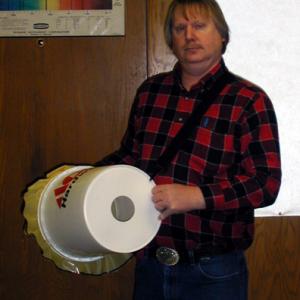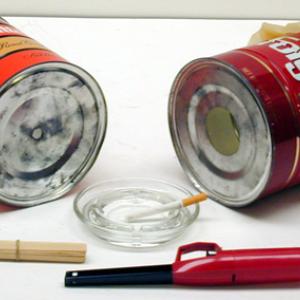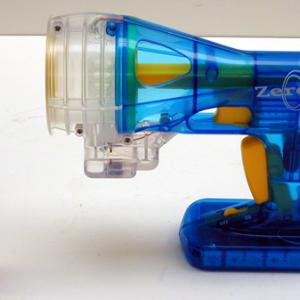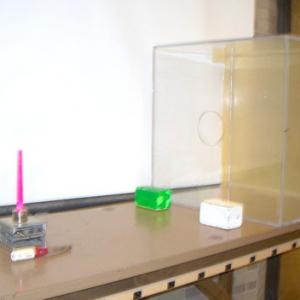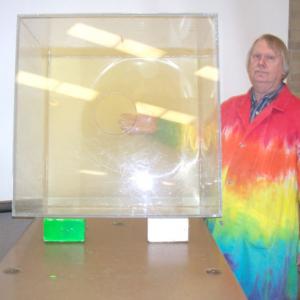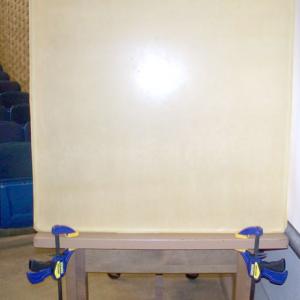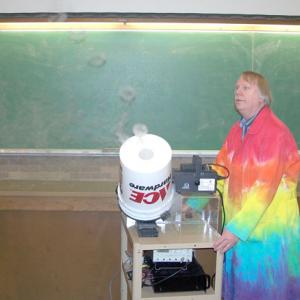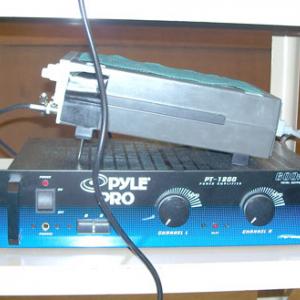College of Liberal Arts & Sciences
2C50.15 - Vortex Rings
NOTE: A set of smaller buckets and masks are in the stand that is used to store the large clear smoke ring generator.
Use the sling on the bucket or garbage can to hold it at a comfortable level. Give the membrane a firm tap. The smoke ring will be nicely visible. Slower traveling rings will allow you to see more vortex structure. You can also use this with or without the smoke to blow out candles from a distance of about 20 feet.
The Zero Blaster can be used to make medium sized smoke rings. An adjustment can be made that allows for slow or fast moving rings.
Tap the diaphragm in a room of quiet (non-moving) air and observe the smoke rings produced. Note that the square hole template will also produce round smoke rings. The elliptical template will produce smoke rings that have observable quadrupole motion which simulates gravitational waves moving through space.
Dimensions for the quadrupolar motion templates are:
22.5 cm major axis X 16.7 cm minor axis
or
22 cm major axis X 13.1 cm minor axis - this one gives a more visible quadrupolar motion with the steel garbage can.
The Machine Gun Smoke Ring Generator is designed for continuous output of smoke rings. Set the wave generator for square waves at about 0.1 Hz. The amplifier will need to be turned up considerably to move the speaker diaphram enough to produce good smoke rings.
- Spencer B. Perry and Kent L. Gee, "The Acoustically Driven Vortex Cannon", TPT, Vol. 52, #3, Mar. 2014, p. 146.
- Elisha Huggins, "Smoke Ring Physics", TPT, Vol. 49, #8, Nov. 2011, p. 488.
- Karen Bouffard, "The Vortex Cannon", TPT, Vol. 38, #1, Jan. 2000, p. 18.
- Ernie McFarland and Tom Kehn, "The Fantastic Physics Fun Show", TPT, Vol. 34, #8, Nov. 1996, p. 51.
- M. Hobbs and C. Roddy, "Where There’s Smoke There’s—A Bee Smoker?", TPT, Vol. 28, #6, Sept. 1990, p. 420.
- Douglas C. Jenkins, "A Thanksgiving Turkey Shoot‐Physics Style", TPT, Vol. 26, #8, Nov.1988, p. 516.
- F. Lee Slick, Roy Coleman, and Ann Brandon, "Doing Physics: Vortex Ring Generator", TPT, Vol. 23, #7, Oct. 1985, p. 434.
- J. T. Lloyd, "Lord Kelvin Demonstrated", TPT, Vol. 18, #1, Jan. 1980, p. 16.
- Christine Middleton, "Dandelion Seeds are Optimized for Wind-Based Travel", Physics Today, Vol. 72, #1, Jan. 2019, p. 17.
- Ashley G. Smart, "Taking the Measure of Water's Whirl", Physics Today, Vol. 70, #10, Oct. 2017, p. 20.
- R. Mark Wilson, "Classical Precursor to Turbulence Observed in a Superfluid", Physics Today, Vol. 70, #1, Jan. 2017, p. 19.
- Ashley G. Smart, "A Vortex Knot Caught on Camera", Physics Today, Vol. 66, #5, May 2013, p. 18.
- Peter A. Irwin, "Vortices and Tall Buildings: A Recipe for Resonance", Physics Today, Vol. 63, #9, Sept. 2010, p. 68.
- Martin W. Scheeler, Wim M. van Rees, Hridesh Kedia, Dustin Kleckner, William T. M. Irvine, "Complete Measurement of Helicity and Its Dynamics in Vortex Tubes", Science, Vol. 357, #6350, Aug. 2017, p. 487.
- H. Keith Moffatt, "Helicity—Invariant Even in a Viscous Fluid", Science, Vol. 357, #6350, Aug 2017, p. 448.
- Clarence D. Cone Jr., "The Soaring Flight of Birds", American Scientific, Vol. 206, #4, Apr. 1962, p. 130.
- C. L. Stong, "The Amateur Scientist: Curious Oscillators That Involve Salt Water, Flame and Hot Wire", Scientific American, Vol. 223, #3, Sept. 1970, p. 221.
- C. L. Stong, "The Amateur Scientist: On a Paradoxical Pump, Reversing Cubes, Vortex Rings, and Various Other Matters", Scientific American, Vol. 212, #1, Jan. 1965, p. 118.
- F. Reif, "Quantized Vortex Rings in Superfluid Helium", Scientific American, Vol. 211, #6, Dec. 1964, p. 116.
- Dianna Cowern, "How To Create Vortex Rings In Your Swimming Pool", Popular Science, Vol. 288, #4, July/Aug. 2016, p. 92.
- Rachel Nuwer, "Turn Up the Bass, Turn Down the Heat", Popular Science, Aug. 2015, p. 63.
- Rachel Fobar, "How to Blow Smoke Rings in a Safer Way", Popular Science, July, 2015.
- G. D. Freier and F. J. Anderson, "Fp-1. Vortex Rings", A Demonstration Handbook for Physics.
- "F-285. Vortex Generators", DICK and RAE Physics Demo Notebook.
- "W-005. Air Cannon", DICK and RAE Physics Demo Notebook.
- Tik Liem, "1.43. The Smoke Ring Race", Investigation to Science Inquiry, p. 47.
- Tik Liem, "1.42. Make an Air Bullet Shooter", Investigation to Science Inquiry, p. 46.
- 50 Fun Experiments for the Mad Scientist in You, "Myo Giant Air Cannon", National Geographic Kids, p. 106 - 107.
- Martin C. Sagendorf, "18. Vortex Generator", Physics Demonstration Apparatus, 2009, p. 58.
- George M. Hopkins', "An Experiment in Acoustics", Experimental Science, Volume Two, p. 204 - 206.
- George M. Hopkins, "Vortex Motion", Experimental Science, p. 113 - 115.
- Martin Gardner, "Smoke Rings", Entertaining Science Experiments with Everyday Objects, p. 106.
- Borislaw Bilash II and David Maiullo, "Smoke Ring Cannon", A Demo a Day: A Year of Physics Demonstrations, p. 200 - 201.
- R. D. Edge, "3.07. Vortex Rings", String and Sticky Tape Experiments.
- Christopher P. Jargodzki and Franklin Potter, "138. Smoke Rings II", Mad About Physics, p. 51, 194.
- Christopher P. Jargodzki and Franklin Potter, "137. Smoke Rings I", Mad About Physics, p. 50, 193.
- Cash, Parker and Taylor, "Make a Sound Cannon", 175 More Science Experiments, p. 15.
- H. J. Press, "9. Sugar Fire", Giant Book of Science Experiments, p. 18.
- Julien Clinton Sprott, "2.24, Smoke Rings", Physics Demonstrations, ISBN 0-299-21580-6, p. 128.
- Janice VanCleave's, "82. Smoke Rings", Chemistry for Every Kid: 101 Easy Experiments That Really Work, p. 176 - 177.
- Janice VanCleave, "115. Smoke Rings", 201 Awesome, Magical, Bizzare, & Incredible Experiments, p. 63.
- Janice VanCleave, "19. Vooomm!!! Box", Teaching the Fun of Physics, p. 30.
- Jearl Walker, "2.40. Ring Vortexes", The Flying Circus of Physics Ed. 2, p. 98.
- Jearl Walker, "4.103. Smoke Ring Tricks", The Flying Circus of Physics with Answers, p. 105, 263.
- Jearl Walker, "4.74, Vortex Rings From Falling Drops", The Flying Circus of Physics with Answers, p. 96, 260.
- Robert Ehrlich, "H.14. Vortex Ring", Turning the World Inside Out, p. 108 - 109.
- "Sounds Interesting", The Usborne Book of Science Experiments, p. 10.
- Brian Carusella, "Sound Rings, Bizarre Stuff", 1997 - 2002.
- Brian Carusella, "The Sugar Cube Page", Bizarre Stuff, 1997 - 2002.
Disclaimer: These demonstrations are provided only for illustrative use by persons affiliated with The University of Iowa and only under the direction of a trained instructor or physicist. The University of Iowa is not responsible for demonstrations performed by those using their own equipment or who choose to use this reference material for their own purpose. The demonstrations included here are within the public domain and can be found in materials contained in libraries, bookstores, and through electronic sources. Performing all or any portion of any of these demonstrations, with or without revisions not depicted here entails inherent risks. These risks include, without limitation, bodily injury (and possibly death), including risks to health that may be temporary or permanent and that may exacerbate a pre-existing medical condition; and property loss or damage. Anyone performing any part of these demonstrations, even with revisions, knowingly and voluntarily assumes all risks associated with them.
